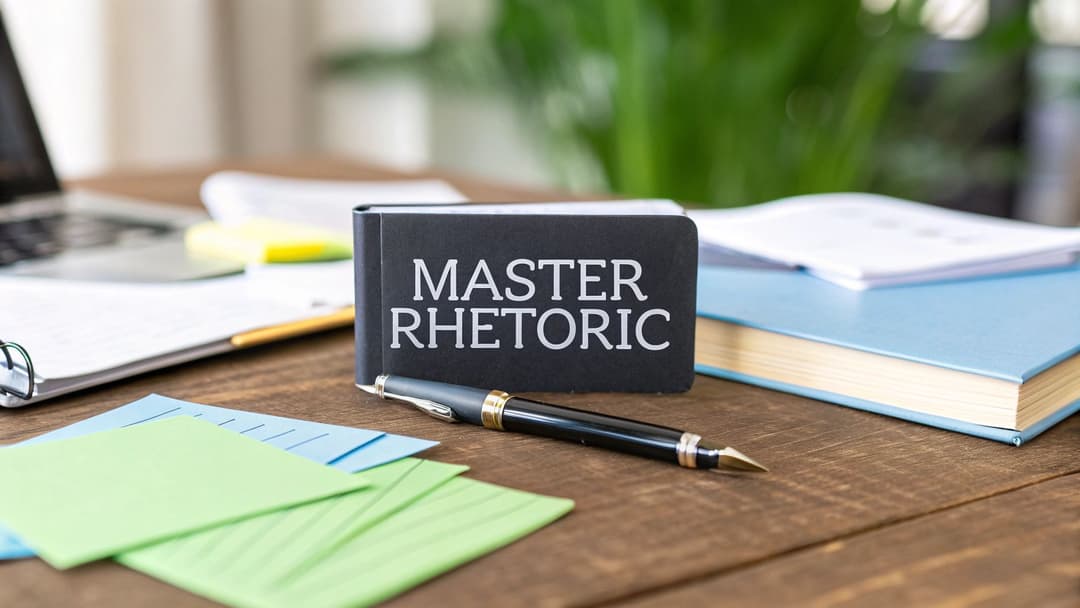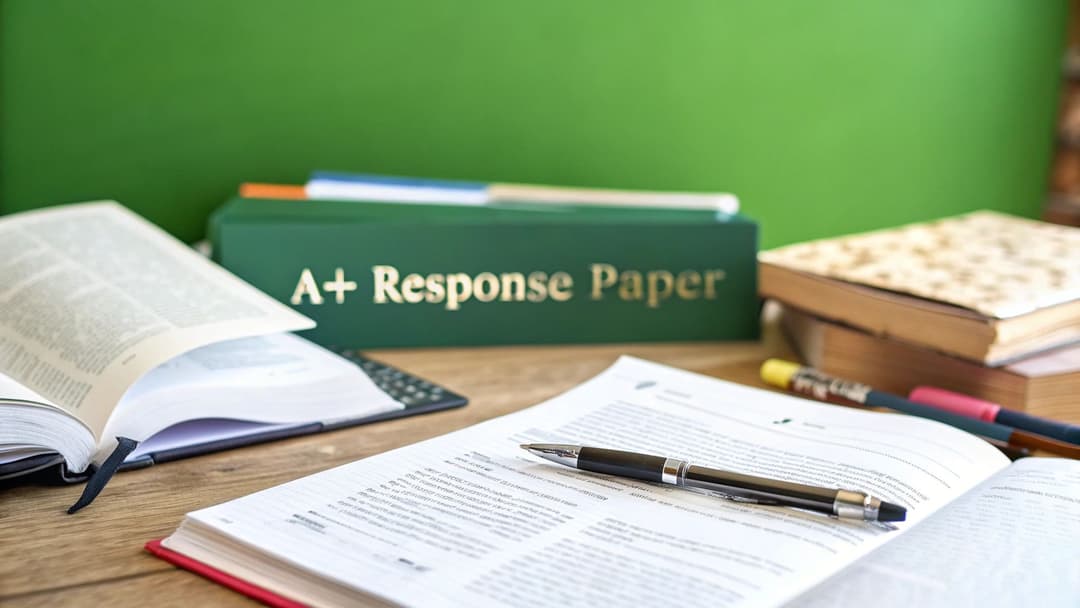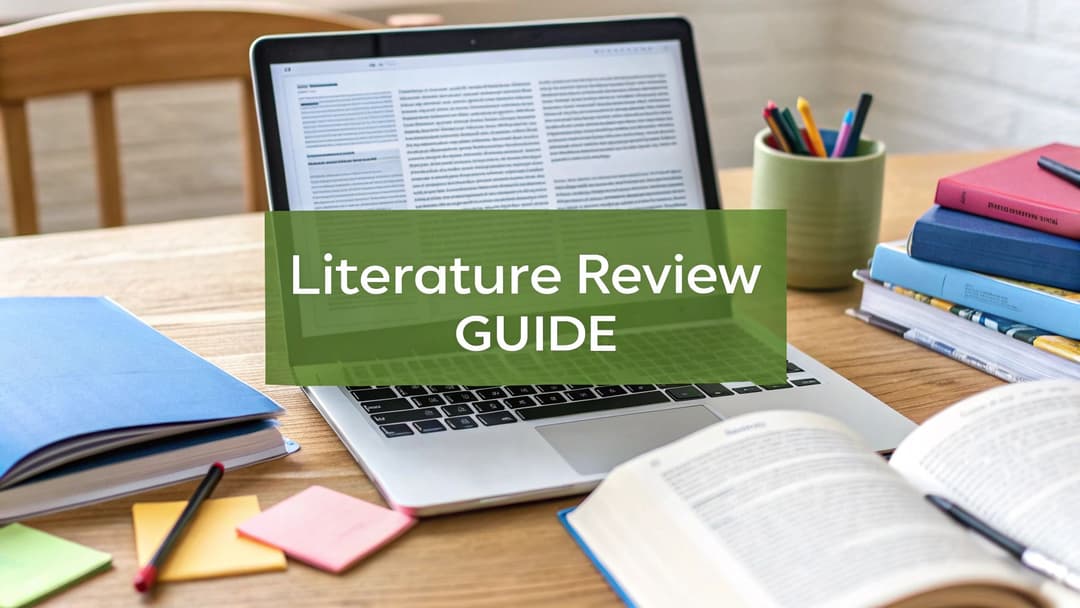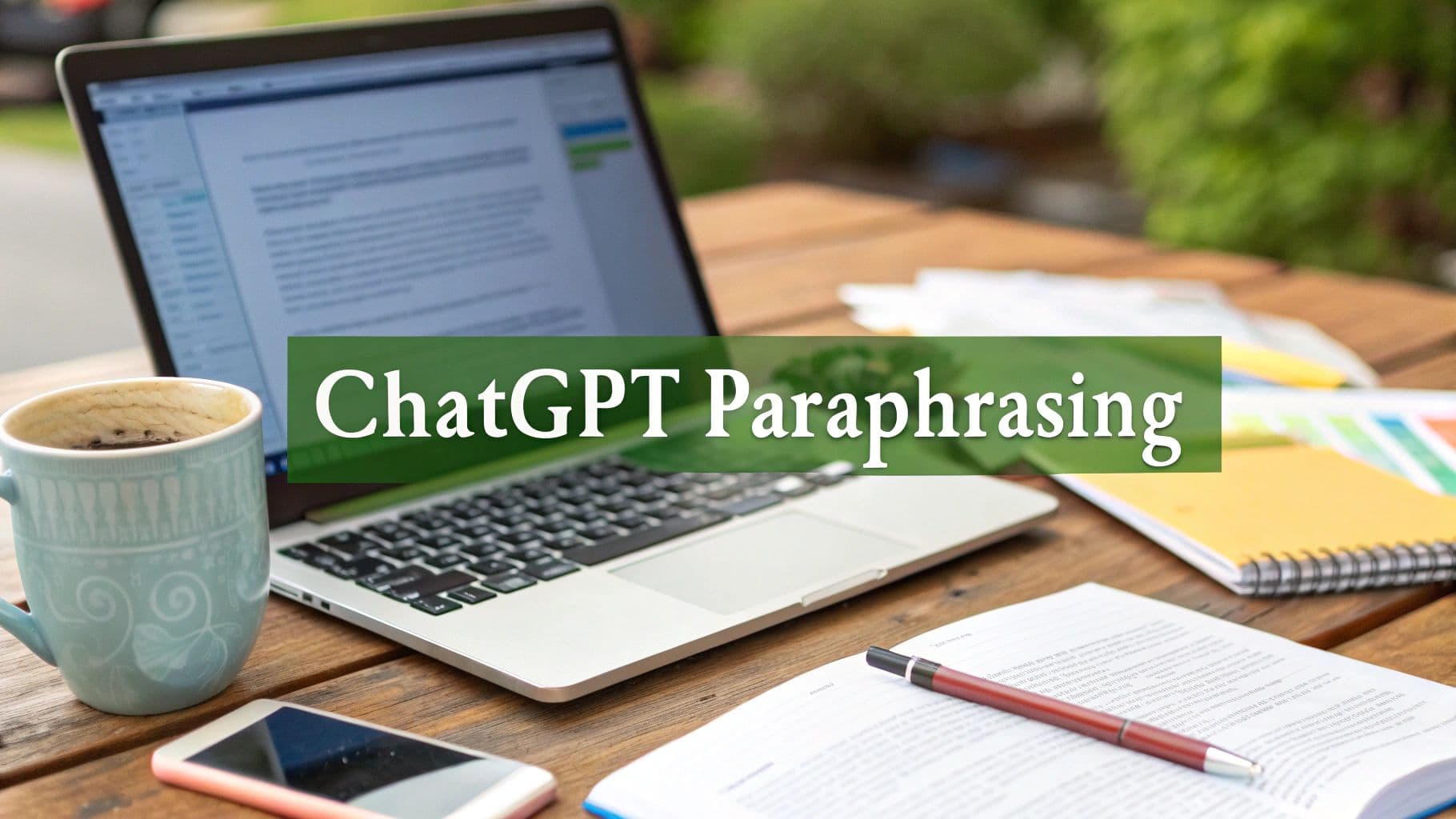
A Guide to Effective Chat GPT Paraphrasing
October 17, 2025
Using ChatGPT to paraphrase isn't just about swapping out a few words. It’s about strategically transforming your content. For professionals, it's a way to quickly adapt complex information for different audiences, smash through writer's block, and spin up multiple content variations from a single source.
Why Smart Professionals Use ChatGPT for Paraphrasing
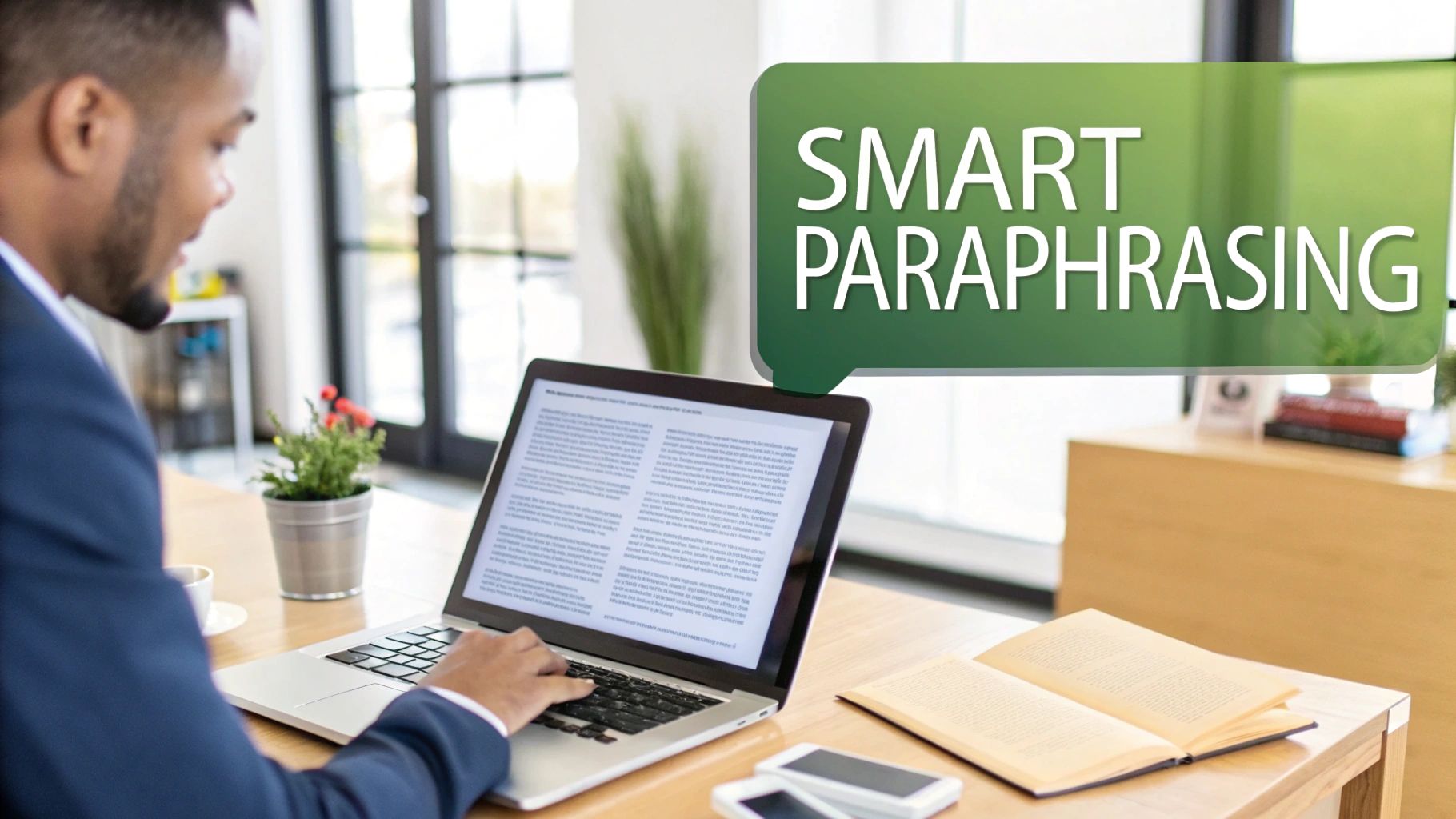
Seasoned writers and marketers see ChatGPT as much more than a simple rephrasing tool; it’s a strategic partner. The world of AI content creation has made tools like this essential for anyone who needs to work fast without letting quality slide.
Think about it. You’ve got a dense, technical white paper. With the right prompt, you can instantly pull out its core message and reshape it into an engaging LinkedIn post, a simplified email newsletter, or a handful of sharp, informative tweets. This is where the real power is.
The Strategic Advantage of AI-Assisted Rewriting
The core benefit here isn’t just speed—it’s about perspective. ChatGPT can offer fresh angles on tired material, helping you escape the creative rut that hits when you're rewriting your own work for the tenth time. It’s a lifesaver for tasks that usually eat up hours, like:
- Simplifying Jargon: Making technical stuff accessible to a wider audience.
- Adjusting Tone: Shifting from a stiff, formal voice to a casual, conversational one.
- Repurposing Content: Turning a single piece of content into assets for multiple platforms.
The goal is to use ChatGPT not just to reword your content, but to fundamentally transform it for a specific audience and purpose. It’s about unlocking new value from material you already have.
This approach is why so many people are on board. As of early 2024, ChatGPT had over 180 million monthly active users, and a huge number of them rely on it for writing and paraphrasing tasks. That user base alone shows how effective it is in both personal and professional settings. You can dive deeper into these trends and discover insights on ChatGPT user statistics to see just how widespread it's become. By adding this tool to your workflow, you can offload the grunt work and focus more on the big-picture strategy.
Crafting Paraphrasing Prompts That Actually Work
If you've ever asked ChatGPT to "rephrase this" and gotten back something that was just… okay, you're not alone. Vague prompts lead to vague results. You’re leaving way too much up to chance.
Effective chat gpt paraphrasing comes down to giving clear, specific instructions. Think of yourself as a director and ChatGPT as your actor. You wouldn't just say, "Act sad." You'd give context: "You just lost something important, but you're trying to stay strong for your family." The more context you provide, the better the performance. It's the same exact principle here.
First, What’s Your Goal?
Before you even start writing a prompt, get clear on your objective. Are you trying to simplify a dense academic text for a general audience? Or maybe you need to change a formal corporate announcement into something more casual and friendly.
Each of these goals requires a totally different set of instructions. Getting this right is the foundation of a good paraphrase.
- To Simplify: Be specific about the audience. For instance, "Explain this scientific abstract like you're talking to a high school biology class."
- To Change the Tone: Clearly state the emotional vibe you're going for. A good example is, "Rewrite this corporate memo in a friendly, conversational voice for a team chat."
- To Rework the Structure: Tell the AI exactly what you want the final format to look like. Try something like, "Turn these bullet points about product features into a single, persuasive paragraph."
The infographic below really nails this simple three-part process for building better prompts.
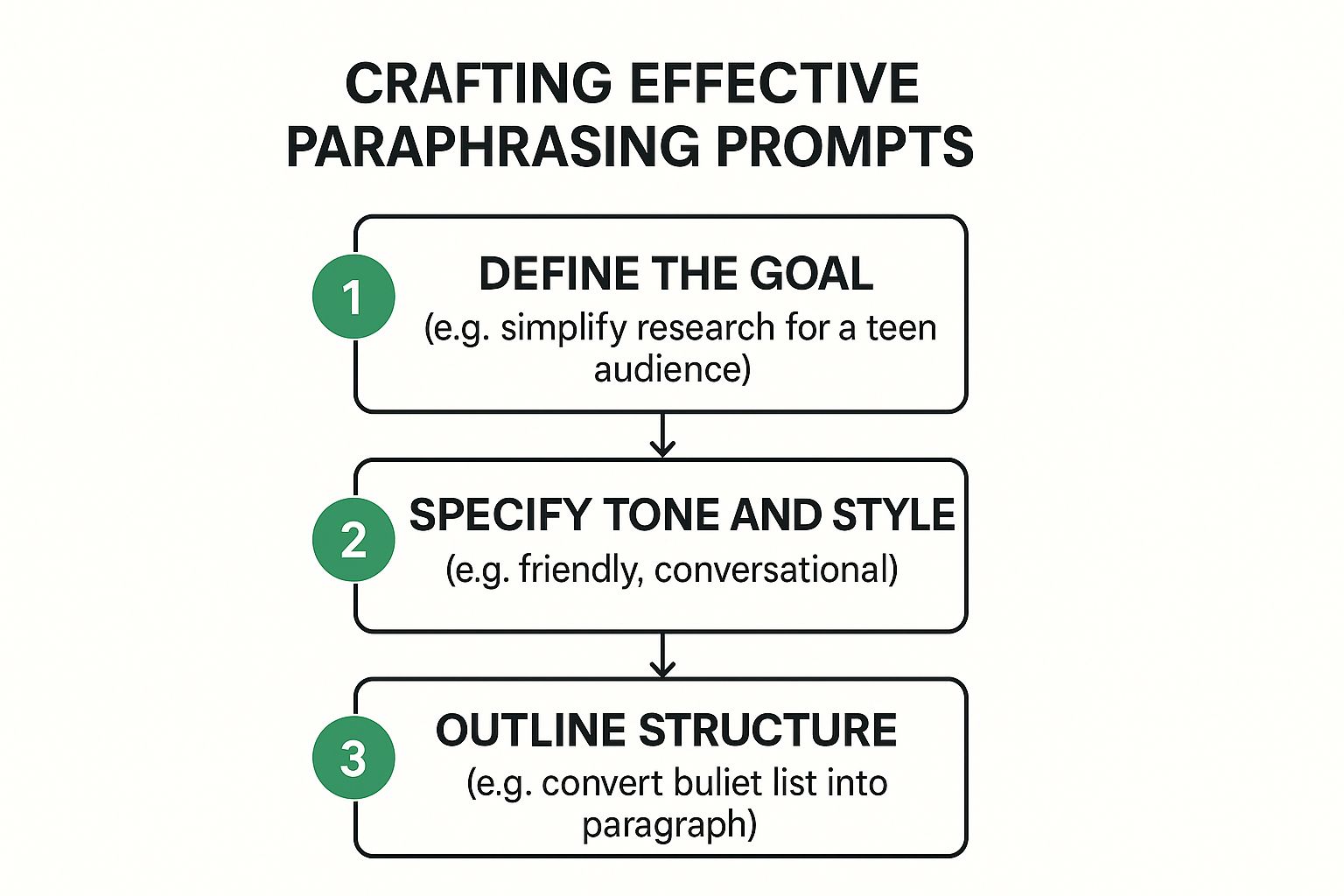
As you can see, combining a clear goal, a specific tone, and a defined structure is how you unlock precise, genuinely useful content from ChatGPT.
From Theory to Actionable Prompts
Alright, let's get practical. Instead of just making a generic request, try layering your instructions to get a much more nuanced result.
To show you what I mean, imagine you have a technical description for a new software feature.
Original Text: "The new asynchronous data processing module leverages a multi-threaded architecture to optimize resource allocation, thereby minimizing latency and enhancing throughput for concurrent user requests."
A basic "Paraphrase this" prompt would just spit back a slightly reworded—but still jargon-heavy—version. An advanced prompt, on the other hand, takes full control.
Prompt Comparison From Basic to Advanced
See how small changes in your prompt can drastically improve the quality of your ChatGPT paraphrasing output.
| Goal | Basic Prompt (Less Effective) | Advanced Prompt (More Effective) |
|---|---|---|
| Simplify Jargon | "Paraphrase this." | "Paraphrase the following text for a non-technical marketing email. Adopt a simple, benefit-focused tone." |
| Change Tone | "Rewrite this to be more casual." | "Rewrite this in a friendly, conversational voice. Explain what this means for the user in practical terms." |
| Remove Technicalities | "Make this easier to understand." | "Rewrite this, avoiding all technical jargon like 'asynchronous' and 'multi-threaded architecture'." |
By combining these elements, you get a much stronger prompt.
Combined Advanced Prompt: "Paraphrase the following text for a non-technical marketing email. Adopt a simple, benefit-focused tone. Explain what this means for the user in practical terms, avoiding all technical jargon like 'asynchronous' and 'multi-threaded architecture'."
This level of detail ensures the output isn't just different—it's purposeful. The paraphrased text is now directly aligned with a specific communication goal, which is the whole point of working with AI effectively. By being prescriptive, you turn ChatGPT from a simple synonym-finder into a powerful tool for adapting content.
And for those times when you need to polish the AI's output even further, using a dedicated AI paragraph rewriter can add that final human touch.
Advanced Techniques for Expert-Level Paraphrasing

Getting beyond simple rewording is what separates the okay results from the truly professional ones. If you want to handle complex material with more nuance, you'll need to move past basic prompts. These more sophisticated techniques are where chat gpt paraphrasing really shines.
One of the most effective strategies I've found is Chain of Thought (CoT) prompting. Instead of just asking for a rewrite, you force ChatGPT to "think" through the material first. You guide it to analyze the context, pull out the main arguments, and understand the meaning before it even starts paraphrasing.
For instance, you might start a prompt with something like, "First, identify the three key arguments in the following text. Then, explain the primary audience. Finally, rewrite the text to be more persuasive for that audience." This multi-step process almost always yields a much deeper, more thoughtful output.
Using Role-Playing for a Specific Voice
Another powerful method is to give the AI a persona. I don't just mean specifying a tone—I mean giving ChatGPT a complete role to inhabit. This is perfect for adapting content that needs a very specific, consistent perspective.
Think about these scenarios:
- For dense technical content: "Act as a subject matter expert in marine biology and rephrase this text for a general audience."
- For flat marketing copy: "You are a seasoned copywriter. Rewrite this product description to focus on emotional benefits rather than technical features."
- For confusing educational material: "Assume the role of a patient educator and simplify this medical information for someone with no prior knowledge of the topic."
This role-playing trick ensures the paraphrased text aligns perfectly with the voice and expertise level you're aiming for.
By directing ChatGPT to adopt a specific persona, you're no longer just rewording sentences; you're fundamentally reshaping the content's perspective and authority.
The power behind these advanced techniques comes from models like GPT-4. It was trained on an enormous dataset and can produce up to 25,000 words—a huge leap from its predecessors. It also supports around 26 languages, making it incredibly versatile for substantial paraphrasing projects. If you want to dig deeper, you can explore more about ChatGPT's capabilities and user base to get a better sense of what it can do.
Dodging Plagiarism and AI Detectors
https://www.youtube.com/embed/2q0NlWcTq1Y
Let's be clear: using AI to paraphrase is a massive time-saver. But it comes with a non-negotiable responsibility to produce original, ethical work.
The single biggest mistake you can make is treating ChatGPT's output as a finished product. It's a powerful starting point, but it should never be the final word.
Simply rewording a text isn't enough to sidestep plagiarism or get past an AI detector. Real originality comes from adding your unique perspective, completely restructuring the flow, and weaving in your own insights.
Think of ChatGPT as a research assistant. It gathers and rephrases information for you. You are the author who provides the final analysis and authority.
Verifying and Restructuring for Originality
Your first move, always, should be to fact-check every single claim the AI makes. AI models are notorious for "hallucinating" or presenting outdated information as gospel. Once you've confirmed everything is accurate, it's time to make the text structurally yours.
- Rework the Flow: Break up long, winding sentences. Combine shorter ones to alter the rhythm and make it sound more natural.
- Change Paragraph Structure: Don't just accept the AI's order. Reorder the arguments and write new topic sentences that reflect your point of view.
- Inject Your Voice: This is the most important part. Add personal anecdotes, brand-specific examples, or a unique analysis that only you can provide.
This hands-on editing process is what separates responsible AI use from lazy copying. For a deeper dive, check out our comprehensive guide on how to avoid plagiarism when using writing tools.
Remember, the goal isn't just to pass a detector. It's to create content that is genuinely yours, ensuring you remain the final, accountable author of your work.
The Hard Truth About AI-Generated Text
It’s crucial to approach AI outputs with a healthy dose of skepticism.
For example, one study found that the average plagiarism rate in raw texts from ChatGPT was around 45%. That's a huge red flag. However, the same study noted that iterative prompting—basically, refining your instructions—significantly decreased this rate. This shows the tool can be effective, but it requires careful handling. You can read the full research on AI and plagiarism reduction to understand the nuances.
Ultimately, tools like plagiarism checkers are your final line of defense. By combining diligent, thoughtful editing with these final checks, you can confidently use ChatGPT for paraphrasing while upholding high ethical and professional standards.
Making Your AI-Paraphrased Content Sound Human

This is the final, crucial step in using chat gpt paraphrasing effectively. A technically perfect rewrite can still feel flat, robotic, and totally disconnected from your audience. This is where your creativity meets AI's efficiency.
The main goal here is to break up the monotonous sentence patterns that AI often spits out. Keep an eye out for repetitive sentence starters or a rhythm that feels a little too uniform. This is your chance to inject your unique voice and make it sound like you.
Adding Your Unique Flavor
Think beyond just editing words. Infusing the text with personality is what truly makes it connect. This is where you add the specific elements that an AI, on its own, just can't replicate.
- Personal Anecdotes: Share a brief, relevant story from your own experience. It builds instant connection.
- Brand-Specific Language: Weave in your company’s unique terminology, catchphrases, or inside jokes.
- Conversational Transitions: Use phrases like "But here's the thing..." or "Think about it this way..." to create a much more natural, conversational flow.
Before AI Edit: "The software's integration capabilities are designed for optimal workflow efficiency."
After Human Edit: "What does this actually mean for you? It means the software fits into your workflow, instead of you having to change for it."
That simple shift changes everything.
For those looking to really master this process, our guide on converting AI to human text offers more advanced techniques. Ultimately, this final polish ensures your content doesn't just inform—it engages.
Have Questions About Paraphrasing with ChatGPT?
Even when you've got the hang of it, using ChatGPT for paraphrasing can still leave you with a few nagging questions. Let's clear up some of the most common ones so you can move forward with confidence.
Can I Really Use This for My Academic Papers?
You can, but you have to be extremely careful. The best way to think of it is as a study buddy—it helps you unpack complex ideas and see different ways to phrase them. But you should never, ever submit text that's been directly paraphrased by AI.
First thing's first: check your school's academic integrity policy. Always. The smart approach is to use ChatGPT for brainstorming and getting a first pass, then heavily edit it in your own words. You still need to fact-check everything and, of course, cite your original sources properly. This is non-negotiable if you want to steer clear of plagiarism issues.
Will Paraphrasing with ChatGPT Tank My SEO?
Not if you do it the right way. Google has been pretty clear that it cares about high-quality, helpful content, not whether AI had a hand in making it.
If you’re using ChatGPT to create something genuinely useful and unique that you've refined yourself, you're in the clear. The real SEO danger comes from just spinning existing articles without adding any fresh perspective or value. That kind of low-effort content is exactly what search engines are trying to filter out.
The trick is to use AI as an assistant to amplify your own expertise, not as a shortcut to recycle what's already out there.
What’s the Single Best Prompt for Paraphrasing?
Honestly, there isn't one. The "best" prompt is always the one that’s perfectly aligned with what you're trying to achieve. A simple "rewrite this" might work for a quick fix, but for top-notch results, you have to get specific.
Think about your end goal and build your prompt around it. For instance:
- To make it simpler: "Rewrite this for someone in 5th grade. Just focus on the main point."
- To sound more professional: "Paraphrase this using a formal, professional tone for a business proposal."
- To improve clarity: "Pull out the key arguments from this paragraph and rephrase them without any of the jargon."
The more context you give the AI, the closer it will get to what you actually need.
Ready to turn those AI drafts into something that sounds genuinely human? Natural Write is a free, one-click tool designed to humanize your text, helping it read naturally and get past AI detectors. Give your writing the final polish it deserves at https://naturalwrite.com.
